3.2.1. Physical Fitness and Energy
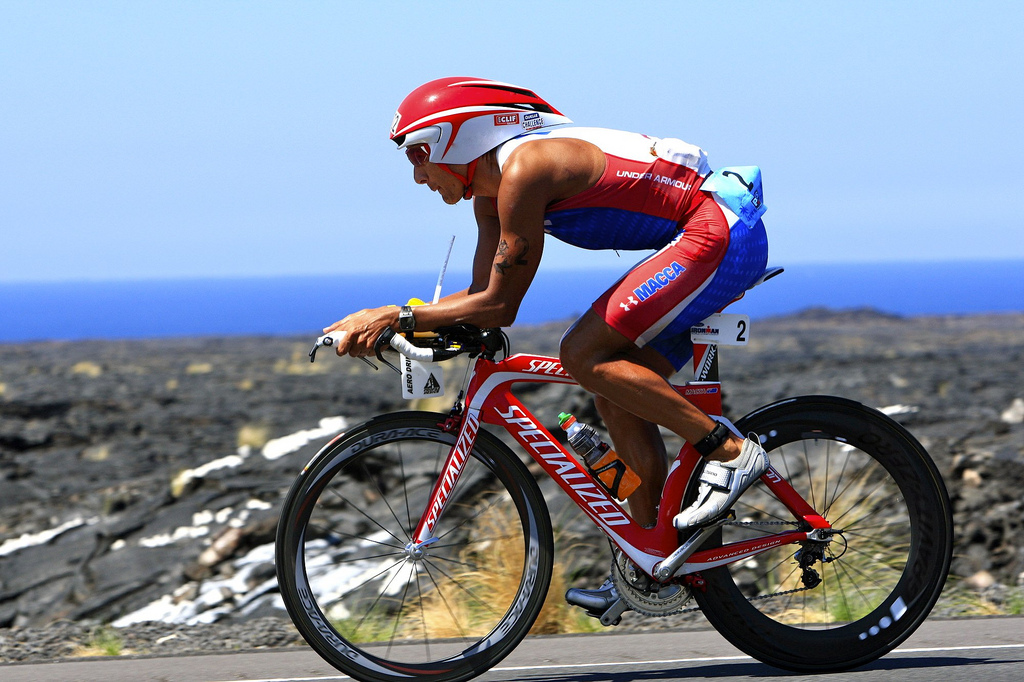
Introduction
Becoming and staying physically fit is an important part of achieving optimal health. A well-rounded exercise program is crucial to becoming and remaining healthy. Physical activity improves your health in a number of ways. It promotes weight loss, strengthens muscles and bones, keeps the heart and lungs strong, and helps to protect against chronic disease. There are four essential elements of physical fitness: cardiorespiratory, muscular strength, flexibility, and maintaining a healthful body composition. Some enthusiasts might argue the relative importance of each, but optimal health requires some degree of balance between all four. For example, the Hawai‘i Ironman is a vigorous race that consists of a 2.4 mile swim, 112 mile bike, and a 26 mile run. All four elements of physical fitness are vital in order to complete each leg of the race. To learn more about the Hawai‘i Ironman, visit their website at http://www.ironman.com.Some forms of exercise confer multiple benefits, which can help you to balance the different elements of physical fitness. For example, riding a bicycle for thirty minutes or more not only builds cardiorespiratory endurance, it also improves muscle strength and muscle endurance. Some forms of yoga can also build muscle strength and endurance, along with flexibility. However, addressing fitness standards in all four categories generally requires incorporating a range of activities into your regular routine. If you exercise regularly, your body will begin to change and you will notice that you are able to continue your activity longer. This is due to the overload principle that our bodies will adapt to with continuous repetition. For example, if you run a mile everyday for a week, in a few weeks you would be able to run further and likely faster.
The Essential Elements of Physical Fitness
Cardiorespiratory Endurance
Cardiorespiratory endurance is enhanced by aerobic training which involves activities that increase your heart rate and breathing such as walking, jogging, or biking. Building cardiorespiratory endurance through aerobic exercise is an excellent way to maintain a healthy weight. Working on this element of physical fitness also improves your circulatory system. It boosts your ability to supply the body’s cells with oxygen and nutrients, and to remove carbon dioxide and metabolic waste. Aerobic exercise is continuous exercise (lasting more than 2 minutes) that can range from low to high levels of intensity. In addition, aerobic exercise increases heart and breathing rates to meet increased demands for oxygen in working muscles. Regular, moderate aerobic activity, about thirty minutes at a time for five days per week, trains the body to deliver oxygen more efficiently, which strengthens the heart and lungs, and reduces the risk of cardiovascular disease.[1] Strengthening your heart muscle and increasing the blood volume pumped each heartbeat will lead to a lower resting heart rate for healthy individuals. Aerobic exercise increases the ability of muscles to use oxygen for energy metabolism therefore creating ATP.
Aerobic capacity, or VO2is the most common standard for evaluating cardiorespiratory endurance. VO2max is your maximal oxygen uptake, and the VO2max test measures the amount of oxygen (in relation to body weight) that you can use per minute. A test subject usually walks or runs on a treadmill or rides a stationary bicycle while the volume and oxygen content of exhaled air is measured to determine oxygen consumption as exercise intensity increases. At some point, the amount of oxygen consumed no longer increases despite an increase in exercise intensity. This value of oxygen consumption is referred to as VO2max, ‘V’ meaning volume, and ‘max’ meaning the maximum amount of oxygen (O2) an individual is capable of utilizing. The higher the number, the more oxygen you can consume, and the faster or longer you can walk, run, bike, or swim, among other aerobic activities. VO2max can increase over time with training.[2]
Figure 3.2.1.1 VO2 Max Test
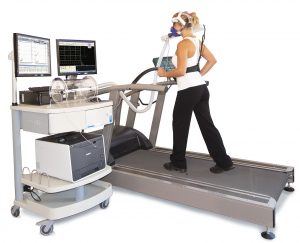
Muscle Strength
Muscle strength is developed and maintained by weight or resistance training that often is called anaerobic exercise. Anaerobic exercise consists of short duration, high intensity movements that rely on immediately available energy sources and require little or no oxygen during the activity. This type of high intensity training is used to build muscle strength by short, high intensity activities. Building muscle mass is not just crucial for athletes and bodybuilders—building muscle strength and endurance is important for children, seniors, and everyone in between. The support that your muscles provide allows you to work, play, and live more efficiently. Strength training involves the use of resistance machines, resistance bands, free weights, or other tools. However, you do not need to pay for a gym membership or expensive equipment to strengthen your muscles. Homemade weights, such as plastic bottles filled with sand, can work just as well. You can also use your own body weight and do push-ups, leg squats, abdominal crunches, and other exercises to build your muscles. If strength training is performed at least twice a week, it can help to improve muscle strength and to increase bone strength. Strength training can also help you to maintain muscle mass during a weight-loss program.[3]
Flexibility
Flexibility is the range of motion available to your joints. Yoga, tai chi, Pilates, and stretching exercises work to improve this element of fitness. Stretching not only improves your range of motion, it also promotes better posture, and helps you perform activities that can require greater flexibility, such as chores around the house. In addition to working on flexibility, older adults should include balance exercises in their regular routine. Balance tends to deteriorate with age, which can result in falls and fractures.[4]
Body Composition
Body composition is the proportion of fat and fat-free mass (which includes bones, muscles and organs) in your body. A healthy and physically fit individual has a greater proportion of muscle and smaller proportion of fat than an unfit individual of the same weight. Although habitual physical activity can promote a more healthful body composition, other factors like age, gender, genetics, and diet contribute to an individual’s body composition. Women have a higher healthy fat percentage than men. For adult women, a healthy amount of body fat ranges from 20 to 32 percent. Adult males on the other hand range from 10 to 22 percent of body fat.[5]
Metabolic Fitness
Being fit also includes metabolic fitness. It relates to the number of calories you require to survive and the number of calories you burn during physical activity. Recall that metabolism is the sum of all chemical reactions that occur in the human body to conduct life’s processes. Some are catabolic reactions that break down nutrients to supply the body with cellular energy. The rate at which a person burns calories depends on body composition, gender, age, nutritional status, physical activity, and genetics.
Increasing your daily activity and shedding excess body fat helps to improve metabolic fitness. Physical activity also makes weight management easier because it increases energy needs and lean body mass. During moderate to vigorous activity, energy expenditure raises well above the resting rate. With continuous exercise over time, regular exercise increases lean body mass as well. At rest, lean tissues use more energy than fat tissue therefore increasing basal metabolism. The combination of increased energy output, energy expenditure and basal needs over a long period of time can have a major impact on total energy expenditure. The more energy you expend, the more foods you are able to consume while maintaining a healthy weight. Any improvement to metabolic fitness is beneficial and means a decrease in the risk for developing diabetes, or other chronic conditions.
One measurement of metabolic fitness is basal metabolic rate, or BMR, which is a measurement of the amount of energy required for the body to maintain its basic functions while at rest, i.e. breathing, heart beats, liver and kidney function, and so on. On average, BMR accounts for between 50 and 70 percent of a person’s total daily energy expenditure. Different factors can affect the BMR. For example, a slender person who is tall has more body surface area and therefore has a higher RMR relative to their body mass (weight). Also, muscle utilizes more energy at rest than fat, so a person with more muscle mass has a higher BMR.
A second measurement of metabolic fitness is the number of calories burned during physical activity. The amount of calories burned depends on how much oxygen is delivered to tissues, and how efficiently metabolic reactions consume oxygen and, therefore, expend calories. One of the best estimates of energy expenditure during exercise is how much oxygen a person consumes. Recall that VO2 max is a measure of the maximum cardiorespiratory capacity to deliver oxygen to the body, especially to working muscles during exercise. Greater VO2 max is indicative of better cardiovascular fitness. In contrast to RMR, VO2 max increases significantly with exercise training due to training adaptations that increase the body’s ability to deliver oxygen to working tissues and an increased capacity of muscles to take up and utilize oxygen.
Figure 3.2.1.2 The Effect of Physical Activity on Energy Expenditure
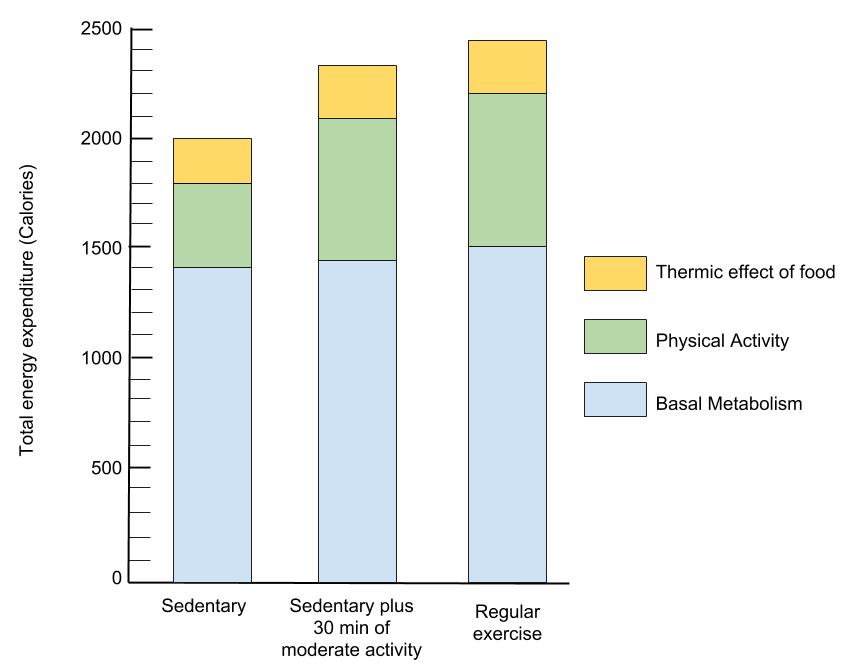
Physical Activity Recommendations
The CDC along with the American College of Sports Medicine (ACSM) have evidence based recommendations and guidelines for individuals to follow in order to obtain or maintain a healthy lifestyle. Adults should get at least 150 minutes of moderate-intensity aerobic physical activity or 75 minutes of vigorous-intensity aerobic physical activity each week. In addition to aerobic physical activity, it is recommended that adults do muscle strengthening activities on each major muscle group two or three times each week. Adults also are recommended by the ACSM to do flexibility exercises at least two to three times a week to improve range of motion. To learn more about these guidelines visit the CDC website at https://health.gov/paguidelines/guidelines/adults.aspx and the ACSM website at http://www.acsm.org/about-acsm/media-room/news-releases/2011/08/01/acsm-issues-new-recommendations-on-quantity-and-quality-of-exercise.
The Benefits of Physical Activity
Regular physical activity is one of the best things you can do to achieve optimal health. Individuals who are physically active for about seven hours per week lower the risk of dying early by 40 percent compared to those who are active for less than thirty minutes per week.[6] Improving your overall fitness involves sticking with an exercise program on a regular basis. If you are nervous or unsure about becoming more active, the good news is that moderate-intensity activity, such as brisk walking, is safe for most people. Also, the health advantages of becoming active far outweigh the risks. Physical activity not only helps to maintain your weight, it also provides a wealth of benefits—physical, mental, and emotional.
Physical Benefits
Getting the recommended amount of physical activity each week, about 150 minutes of moderate, aerobic exercise, such as power walking or bicycling, does not require joining a gym, or taking expensive, complicated classes. If you can’t commit to a formal workout four to five days per week, you can become more active in simple ways—by taking the stairs instead of the elevator, by walking more instead of driving, by going out dancing with your friends, or by doing your household chores at a faster pace. It is not necessary to perform at the level of a professional dancer or athlete, or to work out for several hours every day, to see real gains from exercise. Even slightly increased activity can lead to physical benefits, such as the following:
- longer life: A regular exercise program can reduce your risk of dying early from heart disease, certain cancers, and other leading causes of death.
- healthier weight: Exercise, along with a healthy, balanced eating plan, can help you lose extra weight, maintain weight loss, or prevent excessive weight gain.
- cardiovascular disease prevention: Being active boosts HDL cholesterol and decreases unhealthy triglycerides, which reduces the risk of cardiovascular diseases.
- management of chronic conditions: A regular routine can help to prevent or manage a wide range of conditions and concerns, such as metabolic syndrome, type 2 diabetes, depression, arthritis, and certain types of cancer.
- energy boosts: Regular physical activity can improve muscle tone and strength and provide a boost to your cardiovascular system. When the heart and lungs work more efficiently, you have more energy.
- strong bones: Research shows that aerobic activity and strength training can slow the loss of bone density that typically accompanies aging.
Mental and Emotional Benefits
The benefits of an exercise program are not just physical, they are mental and emotional as well. Anyone who has gone for a walk to clear their head knows the mental benefits of exercise firsthand. Also, you do not have to be a marathoner on a “runner’s high” to enjoy the emotional benefits of becoming active. The mental and emotional benefits of physical activity include the following:
- mood improvement: Aerobic activity, strength-training, and more contemplative activities such as yoga, all help break cycles of worry, absorption, and distraction, effectively draining tension from the body.
- reduced risk of depression or reduced symptoms: Some people have called exercise “nature’s antidepressant,” and studies have shown that physical activity reduces the risk of and helps people cope with the symptoms of depression.
- cognitive skills retention: Regular physical activity can help people maintain thinking, learning, and judgement as they age.
- better sleep: A good night’s sleep is essential for clear thinking, and regular exercise promotes healthy, sound sleep. It can also help you fall asleep faster and deepen your rest.
Changing to a More Active Lifestyle
A physically active lifestyle yields so many health benefits that it is recommended for everyone. Change is not always easy, but even small changes such as taking the stairs instead of the elevator, or parking farther away from a store to add a bit more walking into your day can lead to a more active lifestyle and set you on the road to optimal health. When people go one step further by walking or biking on a regular basis, or becoming active by growing and maintaining a garden, they do more than promote their own health—they safeguard the health of the planet, too.
As you change to a more active lifestyle, select an activity that you can integrate into your schedule smoothly, so you can maintain it. For example, instead of making time to get coffee with friends, you might suggest a walk, rollerblading, or going for a swim in the campus pool. Also, find an activity that you will be motivated to do. Some people decide to participate in team sports, such as local soccer or softball leagues, because they enjoy being active with others or like knowing that a team relies on them. Others prefer to take a class, such as spinning or yoga, that is led by an instructor who will motivate them. Still others prefer more solitary pursuits, such as taking a jog alone in their neighborhood. No matter what your preference, you are more likely to stick to a workout program if you enjoy it.
Fuel Sources
The human body uses carbohydrate, fat and protein in food and from body stores as energy. These essential nutrients are needed regardless of the intensity of activity you are doing. If you are lying down reading a book or running the the Honolulu Marathon, these macronutrients are always needed in the body. However, in order for these nutrients to be used as fuel for the body, their energy must be transferred into the high energy molecule known as Adenosine Triphosphate (ATP). ATP is the body’s immediate fuel source of energy that can be generated either with the presences of oxygen known as aerobic metabolism or without the presence of oxygen by anaerobic metabolism. The type of metabolism that is predominately used during physical activity is determined by the availability of oxygen and how much carbohydrate, fat, and protein are used.
Anaerobic and Aerobic Metabolism
Anaerobic metabolism occurs in the cytosol of the muscle cells. As seen in Figure 3.2.1.3 “Anaerobic Versus Aerobic Metabolism”, a small amount of ATP is produced in the cytosol without the presence of oxygen. Anaerobic metabolism uses glucose as its only source of fuel and produces pyruvate and lactic acid. Pyruvate can then be used as fuel for aerobic metabolism. Aerobic metabolism takes place in the mitochondria of the cell and is able to use carbohydrates, protein or fat as its fuel source. Aerobic metabolism is a much slower process than anaerobic metabolism but produces majority of the ATP.
Figure 3.2.1.3 Anaerobic Versus Aerobic Metabolism
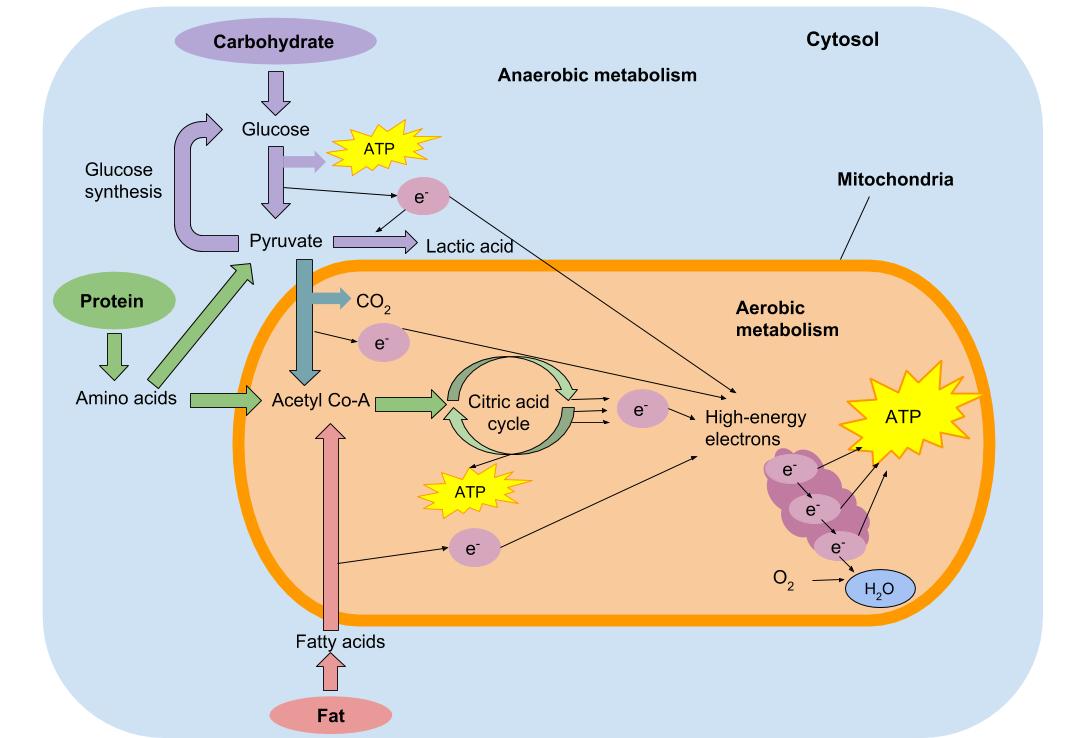
Physical Activity Duration and Fuel Use
The respiratory system plays a vital role in the uptake and delivery of oxygen to muscle cells throughout the body. Oxygen is inhaled by the lungs and transferred from the lungs to the blood where the cardiovascular system circulates the oxygen-rich blood to the muscles. The oxygen is then taken up by the muscles and can be used to generate ATP. When the body is at rest, the heart and lungs are able to supply the muscles with adequate amounts of oxygen to meet the aerobic metabolism energy needs. However, during physical activity your muscles energy and oxygen needs are increased. In order to provide more oxygen to the muscle cells, your heart rate and breathing rate will increase. The amount of oxygen that is delivered to the tissues via the cardiovascular and respiratory systems during exercise depend on the duration, intensity and physical conditioning of the individual.
During the first few steps of exercise, your muscles are the first to respond to the change in activity level. Your lungs and heart however do not react as quickly and during those beginning steps they do not begin to increase the delivery of oxygen. In order for our bodies to get the energy that is needed in these beginning steps, the muscles rely on a small amount of ATP that is stored in resting muscles. The stored ATP is able to provide energy for only a few seconds before it is depleted. Once the stored ATP is just about used up, the body resorts to another high-energy molecule known as creatine phosphate to convert ADP (adenosine diphosphate) to ATP. After about 10 seconds, the stored creatine phosphate in the muscle cells are also depleted as well.
About 15 seconds into exercise, the stored ATP and creatine phosphate are used up in the muscles. The heart and lungs have still not adapted to the increase need of oxygen so the muscles must begin to produce ATP by anaerobic metabolism (without oxygen). Anaerobic metabolism can produce ATP at a rapid pace but only uses glucose as its fuel source. The glucose is obtained from the blood of muscle glycogen. At around 30 seconds, anaerobic pathways are operating at their full capacity but because the availability of glucose is limited, it cannot continue for a long period of time.
As your exercise reaches two to three minutes, your heart rate and breathing rate have increased to supply more oxygen to your muscles. Aerobic metabolism is the most efficient way of producing ATP by producing 18 times more ATP for each molecule of glucose than anaerobic metabolism. Although the primary source of ATP in aerobic metabolism is carbohydrates, fatty acids and protein can also be used as fuel to generate ATP.
Figure 3.2.1.4 The Effect of Exercise Duration on Energy Systems
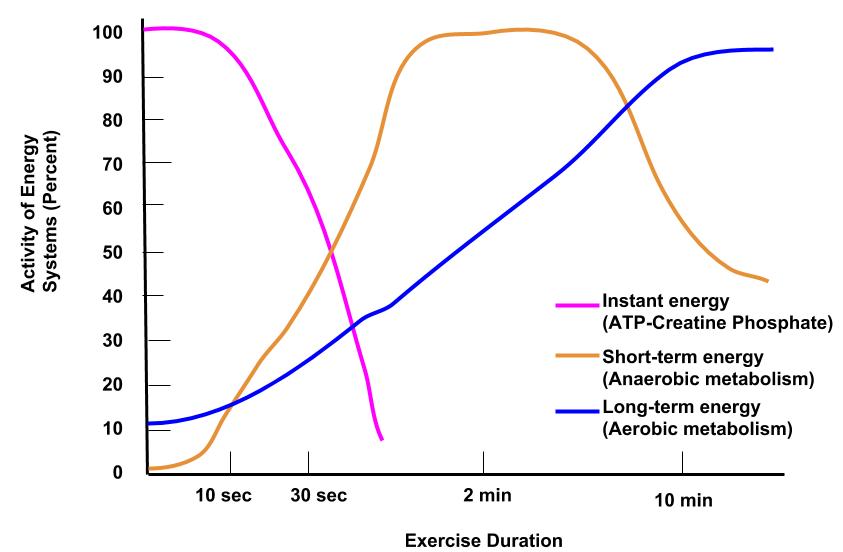
The fuel sources for anaerobic and aerobic metabolism will change depending on the amount of nutrients available and the type of metabolism. Glucose may come from blood glucose (which is from dietary carbohydrates or liver glycogen and glucose synthesis) or muscle glycogen. Glucose is the primary energy source for both anaerobic and aerobic metabolism. Fatty acids are stored as triglycerides in muscles but about 90% of stored energy is found in adipose tissue. As low to moderate intensity exercise continues using aerobic metabolism, fatty acids become the predominant fuel source for the exercising muscles. Although protein is not considered a major energy source, small amounts of amino acids are used while resting or doing an activity. The amount of amino acids used for energy metabolism increase if the total energy intake from your diet does not meet the nutrient needs or if you are involved in long endurance exercises. When amino acids are broken down removing the nitrogen-containing amino acid, that remaining carbon molecule can be broken down into ATP via aerobic metabolism or used to make glucose. When exercise continues for many hours, amino acid use will increase as an energy source and for glucose synthesis.
Figure 3.2.1.5 Fuel Sources for Anaerobic and Aerobic Metabolism
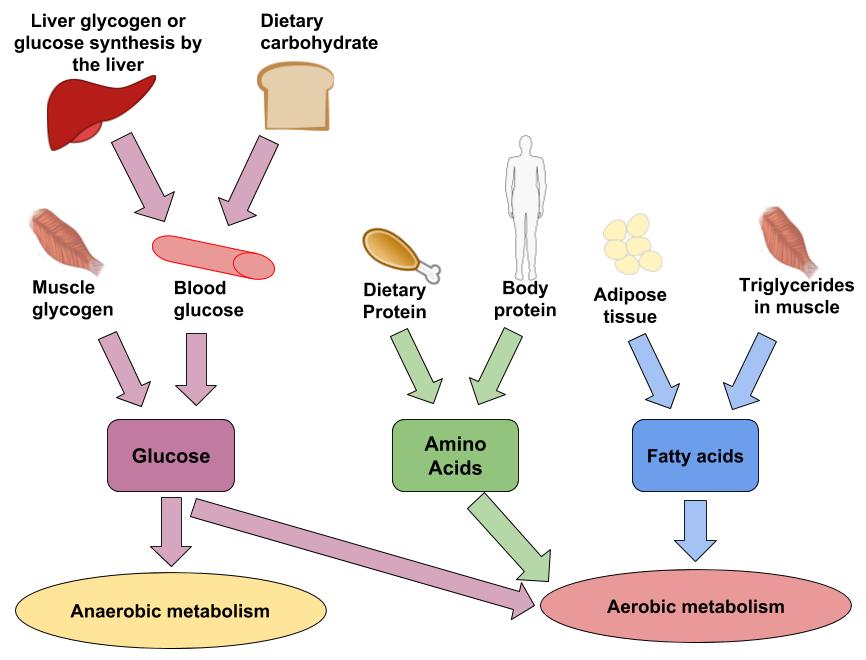
Physical Activity Intensity and Fuel Use
The exercise intensity determines the contribution of the type of fuel source used for ATP production(see Figure 3.2.1.6 “The Effect of Exercise Intensity on Fuel Sources”). Both anaerobic and aerobic metabolism combine during exercise to ensure that the muscles are equipped with enough ATP to carry out the demands placed on them. The amount of contribution from each type of metabolism will depend on the intensity of an activity. When low-intensity activities are performed, aerobic metabolism is used to supply enough ATP to muscles. However, during high-intensity activities more ATP is needed so the muscles must rely on both anaerobic and aerobic metabolism to meet the body’s demands.
During low-intensity activities, the body will use aerobic metabolism over anaerobic metabolism because it is more efficient by producing larger amounts of ATP. Fatty acids are the primary energy source during low-intensity activity. With fat reserves in the body being almost unlimited, low-intensity activities are able to continue for a long time. Along with fatty acids, a small amount of glucose is used as well. Glucose differs from fatty acids where glycogen storages can be depleted. As glycogen stores are depleted, fatigue will eventually set in.
Figure 3.2.1.6 The Effect of Exercise Intensity on Fuel Sources
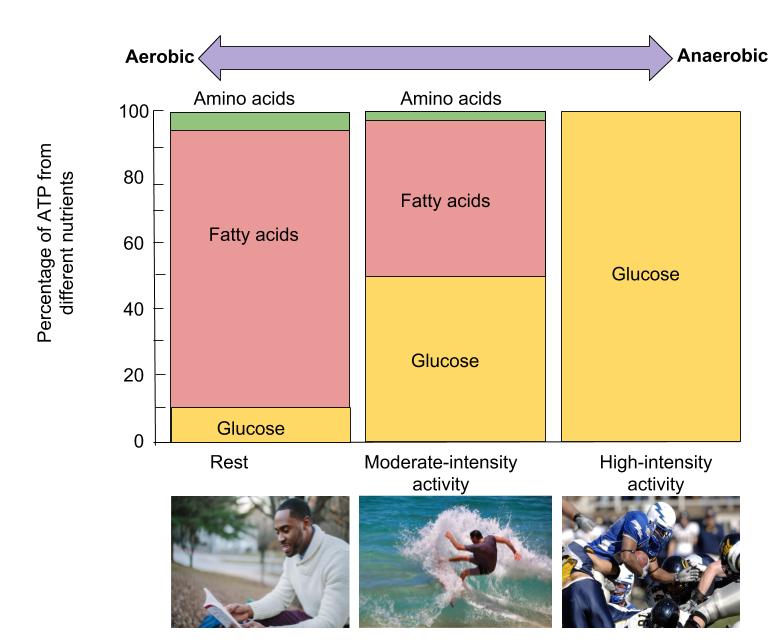
The Fat-Burning Zone
The fat-burning zone is a low intensity aerobic activity that keeps your heart rate between 60 and 69% of your maximum heart rate. The cardio zone on the other hand is a high intensity aerobic activity that keeps the heart rate between about 70 to 85% of your maximum heart rate. So which zone do you burn the most fat in? Technically, your body burns a higher percentage of of calories from fat during a low intensity aerobic activity but there’s more to it than just that. When you begin a low intensity activity, about 50% of the calories burned comes from fat whereas in the cardio zone only 40% comes from fat. However, when looking at the actual numbers of calories burned, higher intensity activity burns just as much fat and a much greater total calories overall.
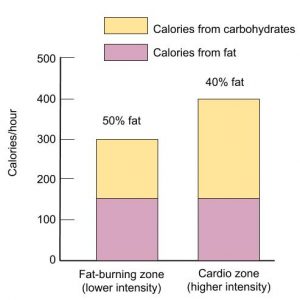
“Hitting the Wall” or “Bonking”
If you are familiar with endurance sports, you may have heard of “hitting the wall” or “bonking.” These colloquial terms refer to the extreme fatigue that sets in after about 120 minutes of performing an endurance sport, such as marathon running or long-distance cycling. The physiology underlying “hitting the wall” means that muscles have used up all their stored glycogen and are therefore dependent on other nutrients to support their energy needs. Fatty acids are transported from fat-storing cells to the muscle to rectify the nutrient deficit. However, fatty acids take more time to convert to energy than glucose, thus decreasing performance levels. To avoid “hitting the wall” or “bonking,” endurance athletes load up on carbohydrates for a few days before the event, known as carbohydrate loading. This will maximize an athlete’s amount of glycogen stored in their liver and muscle tissues. It is important not to assume that carbohydrate loading works for everyone. Without accompanied endurance training you will not increase the amount of stored glucose. If you plan on running a five-mile race for fun with your friend and decide to eat a large amount of carbohydrates in the form of a big spaghetti dinner the night before, the excess carbohydrates will be stored as fat. Therefore, if you are not an endurance athlete exercising for more than 90 minutes, carbohydrate loading will provide no benefit, and can even have some disadvantages. Another way for athletes to avoid “hitting the wall” is to consume carbohydrate-containing drinks and foods during an endurance event. In fact, throughout the Tour de France—a twenty-two-day, twenty-four-hundred-mile race—the average cyclist consumes greater than 60 grams of carbohydrates per hour.
- The American Heart Association Recommendations for Physical Activity in Adults. American Heart Association. Heart.org. http://www.heart.org/HEARTORG/HealthyLiving/PhysicalActivity/FitnessBasics/American-Heart-Association-Recommendations-for-Physical-Activity-Infographic_UCM_450754_SubHomePage.jsp. Accessed March 10, 2018. ↵
- Ed Eyestone. How to Improve Your VO2 Max. RunnersWorld.com. http://www.runnersworld.com/article/0,7120,s6-238-244--12408-0,00.html. Published January 9, 2008. ↵
- American College of Sports Medicine. Resistance Training for Health and Fitness. Acsm.org. https://www.acsm.org/docs/brochures/resistance-training.pdf. Accessed March 11, 2018. ↵
- Fitness Training: Elements of a Well-Rounded Routine. MayoClinic.com. http://www.mayoclinic.com/health/fitness-training/HQ01305. Updated August 10, 2017. ↵
- Measuring and Evaluating Body Composition. ACSM.org. http://www.acsm.org/public-information/articles/2016/10/07/measuring-and-evaluating-body-composition ↵
- Physical Activity and Health: The Benefits of Physical Activity. CDC.org. http://www.cdc.gov/physicalactivity/everyone/health/index.html. Last updated February 16, 2011. ↵

